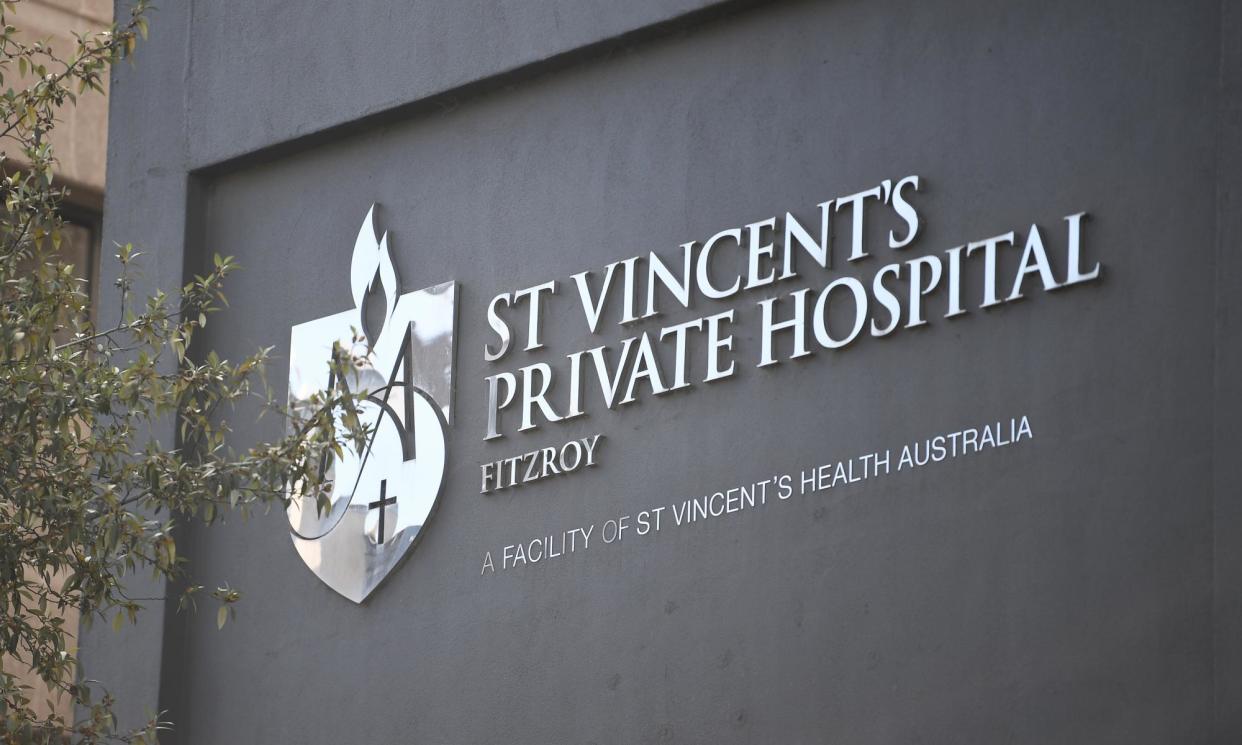Thousands of patients facing healthcare price hikes after negotiations break down between St Vincent’s and NIB

Thousands of patients could face higher out-of-pocket healthcare costs after negotiations broke down between St Vincent’s private hospital network and the private health fund, NIB, for a new funding agreement.
On Thursday, St Vincent’s Health Australia gave notice to NIB that it will walk away from its contract within the next 65 business days unless a fairer funding agreement is reached.
Patients who use NIB for their private health insurance will likely be required to contribute more to the cost of their care when using a St Vincent’s private hospital if a new funding agreement is not reached before the notice period ends on 3 October.
St Vincent’s operates 10 private hospitals in NSW, Victoria and Queensland.
St Vincent’s CEO, Chris Blake, said “this is not a decision we take lightly. This is the first time in our 167-year history that St Vincent’s has given notice to a private health fund that we intend to end our agreement.”
Related: Australian health insurers earn $1.3bn more in surplus than two years ago, report shows
The country’s largest not-for-profit healthcare provider said it had done its utmost to reach an agreement, but NIB had failed to put a fair offer on the table that recognised the rising costs of providing private hospital care.
Blake said inflation had driven up the costs of hospital care including wages, food, energy, personal protective equipment (PPE), IT and maintenance. “For example, in 2023, St Vincent’s electricity costs were $6.5m. In 2024, we expect them to end up closer to $12m.”
In the last 12 months, St Vincent’s had negotiated new agreements with Medibank, HCF and the Alliance group of health funds, which saw both sides give ground, he said.
“But NIB has given us no choice but to make this call.”
NIB CEO and managing director, Mark Fitzgibbon, said the company has had “a long partnership with St Vincent’s, is sympathetic to St Vincent’s financial position, and that of other private hospitals, and has made a very fair and reasonable offer to St Vincent’s”.
“It’s disappointing they have elected to argue their position publicly. But we will continue discussions with them, noting our partnership has several months remaining,” Fitzgibbon said.
The peak body for doctors, the Australian Medical Association urged both parties to get back to the negotiating table and reach an agreement for the sake of patients.
The AMA’s president, Prof Steve Robson said, “patients are ultimately the ones who suffer from this sort of situation, as they will likely face higher out-of-pocket costs for treatment at St Vincent’s network of private hospitals after 3 October this year”.
“These disputes undermine the confidence that Australians have in private health insurance arrangements, particularly as we continue to see significant premium increases at a time people are facing significant cost-of-living pressures,” he said.
Dr Katharine Bassett, the director of health policy at Catholic Health Australia, of which St Vincent’s is a member, said it was “totally unacceptable for insurers to put the squeeze on patients and hospitals while increasing their large profit margins and bank balances”.
“This year NIB had one of the highest premium increases at 4.1%, yet in 2022–23 only returned 79% of premiums back to patients – well short of the industry’s 90% gold standard and the lowest of the major insurers,” Bassett said.
“Today St Vincent’s is rightly taking a stand against insurer power and greed.”
Related: Does Australia need a sugar tax to tackle diabetes, and how would it work?
The ACCC consumer watchdog’s latest report on private health insurance suggested the industry’s net profit after tax has more than doubled– with $2.19bn net profit in 2022-23 up from $1.04bn in 2021–22.
During the last year alone, Bassett said, 71 private hospital services have closed due to financial difficulties.
“Our not-for-profit hospitals are at breaking point, with funding from insurers failing to keep up with the soaring cost of things like food, energy and equipment,” she said.
Blake agreed the situation reflected the “crisis in private healthcare in Australia”.
“For private health care to operate effectively, health funds and hospitals need to work together, and on an even playing field, for the benefit of our members and patients,” Blake said.
The CHA is calling for reforms to the annual premium round process and a new funding model called a National Private Price to ensure funding reflects the actual costs incurred by hospitals.
The AMA is calling for an independent Private Health System Authority (PHSA) to ensure the sector is appropriately regulated, which Robson said would help solve disputes such as these and ensure patients get value for money.


